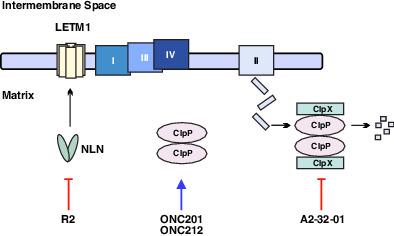当前位置:
X-MOL 学术
›
Stem Cells Transl. Med.
›
论文详情
Our official English website, www.x-mol.net, welcomes your
feedback! (Note: you will need to create a separate account there.)
The role of mitochondrial proteases in leukemic cells and leukemic stem cells.
STEM CELLS Translational Medicine ( IF 5.4 ) Pub Date : 2020-08-05 , DOI: 10.1002/sctm.20-0142 Sara Mirali 1, 2 , Aaron D Schimmer 1, 2
STEM CELLS Translational Medicine ( IF 5.4 ) Pub Date : 2020-08-05 , DOI: 10.1002/sctm.20-0142 Sara Mirali 1, 2 , Aaron D Schimmer 1, 2
Affiliation

|
The biological function of most mitochondrial proteases has not been well characterized. Moreover, most of the available information on the normal function of these proteases has been derived from studies in model organisms. Recently, the mitochondrial proteases caseinolytic protease P (CLPP) and neurolysin (NLN) have been identified as therapeutic targets in acute myeloid leukemia (AML). Both proteases are overexpressed in approximately 40% of AML patients. Mechanistically, CLPP and NLN maintain the integrity of the mitochondrial respiratory chain: CLPP cleaves defective respiratory chain proteins, while NLN promotes the formation of respiratory chain supercomplexes. In this review, we highlight the functional consequences of inhibiting and activating mitochondrial proteases and discuss their potential as therapeutic targets in AML.
中文翻译:

线粒体蛋白酶在白血病细胞和白血病干细胞中的作用。
大多数线粒体蛋白酶的生物学功能尚未得到很好的表征。此外,关于这些蛋白酶正常功能的大部分可用信息都来自对模型生物的研究。最近,线粒体蛋白酶酪蛋白水解蛋白酶 P (CLPP) 和神经溶素 (NLN) 已被确定为急性髓系白血病 (AML) 的治疗靶点。这两种蛋白酶在大约 40% 的 AML 患者中过度表达。从机制上讲,CLPP 和 NLN 保持线粒体呼吸链的完整性:CLPP 裂解有缺陷的呼吸链蛋白,而 NLN 促进呼吸链超复合物的形成。在这篇综述中,我们强调了抑制和激活线粒体蛋白酶的功能后果,并讨论了它们作为 AML 治疗靶点的潜力。
更新日期:2020-08-05
中文翻译:

线粒体蛋白酶在白血病细胞和白血病干细胞中的作用。
大多数线粒体蛋白酶的生物学功能尚未得到很好的表征。此外,关于这些蛋白酶正常功能的大部分可用信息都来自对模型生物的研究。最近,线粒体蛋白酶酪蛋白水解蛋白酶 P (CLPP) 和神经溶素 (NLN) 已被确定为急性髓系白血病 (AML) 的治疗靶点。这两种蛋白酶在大约 40% 的 AML 患者中过度表达。从机制上讲,CLPP 和 NLN 保持线粒体呼吸链的完整性:CLPP 裂解有缺陷的呼吸链蛋白,而 NLN 促进呼吸链超复合物的形成。在这篇综述中,我们强调了抑制和激活线粒体蛋白酶的功能后果,并讨论了它们作为 AML 治疗靶点的潜力。











































 京公网安备 11010802027423号
京公网安备 11010802027423号